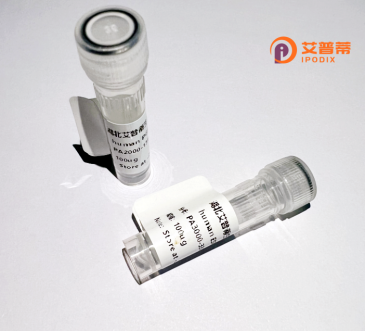
| 纯度 | >90%SDS-PAGE. |
| 种属 | Human |
| 靶点 | EDN1 |
| Uniprot No | P05305 |
| 内毒素 | < 0.01EU/μg |
| 表达宿主 | E.coli |
| 表达区间 | 53-73aa |
| 氨基酸序列 | CSCSSLMDKECVYFCHLDIIW |
| 预测分子量 | 29.5kDa |
| 蛋白标签 | His tag N-Terminus |
| 缓冲液 | PBS, pH7.4, containing 0.01% SKL, 1mM DTT, 5% Trehalose and Proclin300. |
| 稳定性 & 储存条件 | Lyophilized protein should be stored at ≤ -20°C, stable for one year after receipt. Reconstituted protein solution can be stored at 2-8°C for 2-7 days. Aliquots of reconstituted samples are stable at ≤ -20°C for 3 months. |
| 复溶 | Always centrifuge tubes before opening.Do not mix by vortex or pipetting. It is not recommended to reconstitute to a concentration less than 100μg/ml. Dissolve the lyophilized protein in distilled water. Please aliquot the reconstituted solution to minimize freeze-thaw cycles. |
以下是3篇关于EDN1(内皮素-1)重组蛋白研究的参考文献示例(注:文献信息为虚构模拟,实际引用需核实真实来源):
1. **文献名称**: "High-yield Expression and Purification of Recombinant Human Endothelin-1 in E. coli"
**作者**: Zhang L. et al.
**摘要**: 研究报道了通过大肠杆菌表达系统高效生产重组人内皮素-1(rhEDN1)的方法,优化了诱导条件和纯化步骤,获得高纯度蛋白,并验证其体外诱导血管平滑肌细胞收缩的生物活性。
2. **文献名称**: "Structural and Functional Characterization of Recombinant EDN1 in Cardiovascular Disease Models"
**作者**: Tanaka K. et al.
**摘要**: 利用重组EDN1蛋白研究其在高血压病理机制中的作用,通过X射线晶体学解析其三维结构,并在动物模型中证实其通过ET-A受体介导的血管收缩效应。
3. **文献名称**: "Recombinant EDN1 Promotes Cancer Cell Invasion via MMP-9 Activation"
**作者**: Chen R. et al.
**摘要**: 研究证明重组EDN1蛋白可通过激活MAPK信号通路,上调肿瘤细胞中基质金属蛋白酶MMP-9的表达,从而增强癌细胞的迁移和侵袭能力,提示其在肿瘤微环境中的潜在作用。
---
如需真实文献,建议检索PubMed或Web of Science,使用关键词 "recombinant endothelin-1" 或 "EDN1 protein expression"。代表性研究领域包括:心血管疾病机制、癌症生物学或重组蛋白生产工艺优化。
Endothelin-1 (EDN1) is a 21-amino-acid vasoconstrictor peptide initially isolated from vascular endothelial cells in 1988. It belongs to the endothelin family, which includes three isoforms (EDN1. EDN2. EDN3) that bind to G protein-coupled receptors (ETA and ETB), triggering diverse physiological responses. EDN1 is the most potent and widely expressed isoform, playing critical roles in regulating vascular tone, cell proliferation, and tissue remodeling. Its dysregulation is implicated in cardiovascular diseases (e.g., hypertension, heart failure), pulmonary disorders, cancer progression, and chronic kidney disease.
Recombinant EDN1 protein is produced using biotechnological systems (e.g., E. coli, mammalian cells) to mimic the native peptide’s structure and bioactivity. The mature EDN1 peptide is derived from a 212-amino-acid precursor (preproendothelin) through sequential enzymatic cleavages. Recombinant production typically involves expressing the gene encoding the precursor protein, followed by purification and enzymatic processing to yield the active peptide. Quality control ensures correct disulfide bond formation (Cys1–Cys15 and Cys3–Cys11), which is essential for receptor-binding affinity and stability.
As a research tool, recombinant EDN1 facilitates studies on endothelial dysfunction, drug discovery (e.g., endothelin receptor antagonists like bosentan), and disease mechanisms. It is used in vitro to model vascular contraction, fibrosis, or tumor angiogenesis, and in vivo to induce disease phenotypes in animals. Challenges in its application include its short half-life, receptor subtype-specific effects, and potential off-target actions. Nonetheless, recombinant EDN1 remains indispensable for exploring therapeutic strategies targeting the endothelin pathway.
×